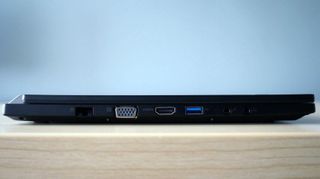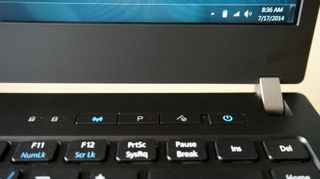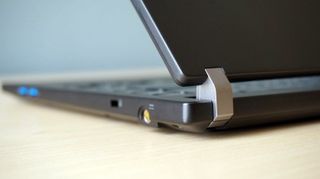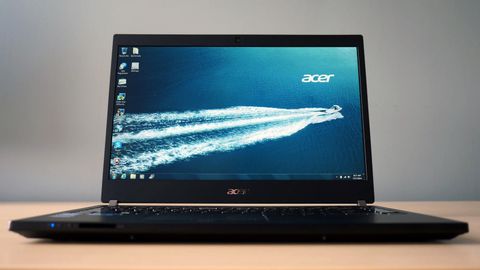Why you can trust TechRadar
If the Acer TravelMate P645's design is impressive, then its insides surely match. Intel's Core i7 processor is a solid chip to base a machine like this around, and 8GB of memory – or 12GB, if you choose to upgrade – is nothing to complain about.
The TravelMate's ports are all conveniently located on the left and right sides, including two USB 3.0 ports on the right and a third on the left. Meanwhile, this laptop excels in the important category of portability.
At 12.9 x 9.3 x 0.81 inches (W x D x H) and just 3.31 pounds, it's both thinner and lighter than the HP ZBook 14, though not as compact as the Lenovo ThinkPad X1 Carbon. Still, the differences are relatively small, and few will complain about the weight of the TravelMate in a bag or under an arm.

This is the Acer TravelMate P645 configuration sent to TechRadar:
Spec sheet
- CPU: 1.8GHz Intel Core i7-4500U (dual-core, 4MB cache, up to 3GHz with Turbo Boost)
- Graphics: AMD Radeon HD 8750M (2GB DDR3 VRAM)
- RAM: 8GB DDR3 SDRAM
- Screen: 14-inch, 1920 x 1080, IPS, (16:9 ratio)
- Storage: 256GB SSD
- Ports: 3 USB 3.0, HDMI-out, VGA, Ethernet, headphone jack, mic jack
- Connectivity: 802.11b/g/n Wi-Fi, Bluetooth, NFC
- Battery: 4850mAh
- Camera: 720p webcam with dual microphones
- Features: TravelMate Trusted Platform Module 1.2 fingerprint reader
- Weight: 3.31 pounds (1.52kg)
- Size: 12.9 x 9.3 x 0.81 inches (328.5 x 235.5 x 20.8 mm) (W x D x H)
This configuration isn't the absolute top-of-the-line for the TravelMate – as I said previously, the RAM can go a bit higher to 12GB. But it gets cheaper as well: you can order a unit with a weaker Core i5 chip, a 1366 x 768 display, and other downgraded specs, starting at $949 (about £560, AU$1,020).
For a few hundred dollars more, it's probably worth getting the upgraded specs, but that obviously depends on your budget, how much power you need, and how many you're ordering.
Meanwhile, another highlight of the TravelMate configuration I reviewed is its 1080p display. The screen is crisp and bright, and it features an attractive, anti-glare matte finish. That makes it harder to smudge and easier to see in all kinds of conditions, a welcome advantage.

However, the display's small size and dense resolution can present problems. For example, reading text in Google Chrome at its default level is straining, and adjusting the system's magnification through the control panel doesn't change the way websites are displayed, at least in Windows 7.
Operating under stress
It should be noted as well that the TravelMate can be ordered with one of several different versions of Windows, from Windows 7 Professional 64-bit to the more modern (but oftentimes more frustrating) Windows 8.1. This option is much appreciated, and no doubt some users are happy to choose the older but more reliable Windows 7, especially considering the laptop's lack of a touchscreen.
Unfortunately the laptop also comes packed with annoying software that will pester you for registrations and updates, including Norton, McAfee and the aforementioned Acer ProShield.

Although it can be useful, ProShield can prove annoying, especially as it produces new, never-before-seen pop-ups even days into using the laptop. These even feature the irksome "remind me later" button rather than a permanent way to dismiss them, only increasing the frustration.
Another bummer: over my several days of using the TravelMate, I experienced no less than three crashes, twice from simply closing the laptop and opening it back up later and once during actual use. For the first two, the computer was plugged in, while it was unplugged but still had 20% of its battery remaining for one crash.
These aberrations sent the TravelMate to Windows 7's white-on-black safe mode boot screen, and from there the computer once even got stuck in a loop, unable to restore my previous session but trying over and over until I intervened. It's worrying that this might occur in the middle of a presentation or while working on a local spreadsheet.

Benchmarks
Unsurprisingly, the TravelMate's benchmark performance relative to some of its rivals correlates inversely with its weight and other dimensions. In other words, the TravelMate scored better than the lighter Lenovo ThinkPad X1 Carbon in most tests, while losing to the heavier HP ZBook 14 in the same ones.
It's clear that you're trading a bit of portability for better performance here, and considering how light and compact the TravelMate remains in spite of that, I'd say that's a fair transaction.
- 3DMark: Ice Storm: 39,323; Cloud Gate: 5,561; Fire Strike: 1,158; Sky Diver: 2,549
- Cinebench: CPU: 2.6 cb; Graphics: 42.42 fps
- PCMark 8 Creative: 2,281; Work: 2,994
- PCMark 8 Battery Life: 3 hours and 34 minutes
Meanwhile, the TravelMate actually beat both of those competitors in two categories: graphics performance and battery life. The latter will no doubt prove important, though so might the former, depending upon the type of enterprise user – say, heavy users of programs like AutoCAD.

That battery life is advertised at around 8 hours, and for users on a flight (or other long-use, no-power-plug scenarios) who are just using a text editor, spreadsheets and other business applications, that may prove accurate. But with normal to heavy use, the benchmark test's estimation of three and a half hours proved more accurate, though still slightly off the mark.
Writing in WordPad while streaming songs through Spotify, browsing the web in Chrome, and downloading a few games with Steam with the brightness and volume at their maximums drained the TravelMate's battery in around four hours. That's fairly impressive, when you consider everything that was going on, and it makes me think the battery might actually last much longer than eight hours with more conservative use.
Michael Rougeau is a former freelance news writer for TechRadar. Studying at Goldsmiths, University of London, and Northeastern University, Michael has bylines at Kotaku, 1UP, G4, Complex Magazine, Digital Trends, GamesRadar, GameSpot, IFC, Animal New York, @Gamer, Inside the Magic, Comic Book Resources, Zap2It, TabTimes, GameZone, Cheat Code Central, Gameshark, Gameranx, The Industry, Debonair Mag, Kombo, and others.
Micheal also spent time as the Games Editor for Playboy.com, and was the managing editor at GameSpot before becoming an Animal Care Manager for Wags and Walks.


